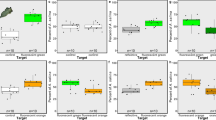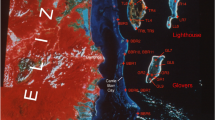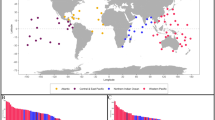Abstract
Massive coral colonies on the Great Barrier Reef grow outwards at 5–25 mm yr−1 (ref. 1). Skeletal density varies seasonally in all massive corals from the Great Barrier Reef and an exact temporal record of growth can be obtained by X-radiography of appropriately cut sections of the colony2,3. Environmental influences on coral growth have been described from such analyses4–6. This is the first report from the skeletons of massive corals of yellow green fluorescent bands which appear under long-wave UV light. Such fluorescence is confined to corals growing within 20 km of the shore and is not present in massive corals from mid- and outer shelf reefs of the central Great Barrier Reef region. The timing, width and intensity of the fluorescent bands correlate strongly with summer, monsoonal rainfall and coastal runoff. Large colonies, several centuries old, can provide long records of the strength and periodicity of terrestrial runoff to the tropical nearshore environment. Such records are potentially important to climatology, meteorology, agriculture, civil engineering and management of the Great Barrier Reef.
This is a preview of subscription content, access via your institution
Access options
Subscribe to this journal
Receive 51 print issues and online access
$199.00 per year
only $3.90 per issue
Buy this article
- Purchase on Springer Link
- Instant access to full article PDF
Prices may be subject to local taxes which are calculated during checkout
Similar content being viewed by others
References
Isdale, P. J. thesis, James Cook Univ., North Queensland (1981).
MacIntyre, I. G. & Smith, S. V. Proc. 2nd int. Coral Reef Symp. 2 (GBRC, Brisbane, 1974).
Buddemeier, R. W. & Kinzie, R. A. III Oceanogr. mar. Biol. A. Rev. 14, 183–225 (1976).
Buddemeier, R. W. Proc. 2nd int. Coral Reef Symp. Vol. 2, 259–267 (GBRC, Brisbane, 1974).
Dodge, R. E., Aller, R. C. & Thomson, J. Nature 247, 574–577 (1974).
Highsmith, R. C. J. expl mar. Biol. Ecol. 47, 55–67 (1979).
Queensland Water Resource Commission Stream Flow Records 1 (1983).
Wolanski, E. Aust. J. mar. Freshwat. Res. 34, 49–63 (1983).
Wolanski, E. & Jones, M. Aust. J. mar. Freshwat. Res. 32, 305–319 (1981).
Wellington, G. M. & Glynn, P. W. Coral Reefs 1, 215–222 (1983).
Author information
Authors and Affiliations
Rights and permissions
About this article
Cite this article
Isdale, P. Fluorescent bands in massive corals record centuries of coastal rainfall. Nature 310, 578–579 (1984). https://doi.org/10.1038/310578a0
Received:
Accepted:
Issue Date:
DOI: https://doi.org/10.1038/310578a0
This article is cited by
-
Increasing coral calcification in Orbicella faveolata and Pseudodiploria strigosa at Flower Garden Banks, Gulf of Mexico
Coral Reefs (2021)
-
Sub-annual fluorescence measurements of coral skeleton: relationship between skeletal luminescence and terrestrial humic-like substances
Coral Reefs (2020)
-
Temporal and taxonomic contrasts in coral growth at Davies Reef, central Great Barrier Reef, Australia
Coral Reefs (2018)
-
Response of coral calcification and calcifying fluid composition to thermally induced bleaching stress
Scientific Reports (2017)
-
Freshwater impacts in the central Great Barrier Reef: 1648–2011
Coral Reefs (2015)
Comments
By submitting a comment you agree to abide by our Terms and Community Guidelines. If you find something abusive or that does not comply with our terms or guidelines please flag it as inappropriate.



